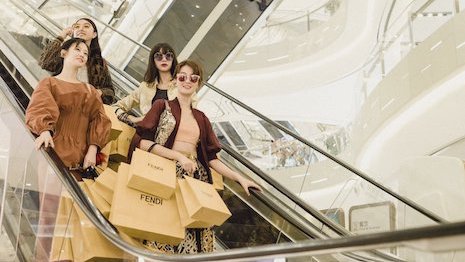- About
- Subscribe Now
- New York,
February 26, 2019

 Today's luxury consumer is most likely to be young and Chinese. Image credit: Fendi
Today's luxury consumer is most likely to be young and Chinese. Image credit: Fendi
The luxury business is not immune to disruptions, as emerging affluent consumers continue to embrace technology, social media and sustainability at rapid rates.
While luxury goods were once characterized by exclusivity, craftsmanship and heritage, the industry has become more democratized in the last decade. According to a new report from Coresight Research, the luxury business is not slowing down but it is shifting towards Asian consumers and away from the more established markets in Europe and the United States.
“Once slow to change, luxury brands are now experimenting with new forms of communication, out-of-the box collaborations and bringing technology into the heart of the business,” said Marie Driscoll, managing director for luxury and fashion at Coresight Research, a global retail think tank, New York. “Long protective of every touchpoint with the consumer, luxury brands are testing the waters of inclusivity and engaging in real conversations with their consumers.”
Changing consumers
The new face of the luxury consumer is young and Chinese.
Although growth of the Chinese economy has seen a slight slowdown – from 6.7 percent in 2017 to 6.5 percent in 2018 – more Chinese consumers are purchasing luxury goods domestically than ever before. Companies need to have a solid understanding of Chinese cultural norms to keep those shoppers engaged and spending.
Younger affluents are looking for transparency regarding sustainability. Image credit: Antibad
Due to the elevated price points and the emphasis on quality, luxury brands face higher expectations regarding sustainability practices. Millennials and Generation Z in particular are building reputations as mindful consumers seeking more transparency surrounding business practices.
Luxury goods conglomerate LVMH Moët Hennessy Louis Vuitton recently introduced new requirements for its crocodilian leather sourcing, as the group continues its quest to be more transparent about animal welfare and other sustainability issues (see story). The new regulations come after other luxury brands have reduced or entirely eliminated their use of fur and other exotic skins.
“The role of the luxury industry in sustainability is evolving,” Ms. Driscoll said. “Many luxury brands practice sustainable business practices in their efforts to ensure quality raw materials and artisanry.”
Aside from the trend toward environmental awareness, there has been a shift in other styles.
"It" handbags are still markers of social currency, and luxury brands continue to look for new ways to market these goods to new generations.
For instance, Italian apparel and accessories label Fendi’s new #BaguetteFriendsForever episodes reintroduce a classic "It" bag to a new audience of affluents who have embraced the logos and silhouettes that initially found popularity in the 1990s (see story).
However casual wear is a dominant trend and sneakers are in high-demand, especially those sold in limited runs.
While ecommerce sales of luxury goods continue to see double-digit annual growth, Coresight finds that online sales only represent about a tenth of total sales. In the meantime, multibrand ecommerce sites have taken advantage and attracted affluents who have embraced online shopping.
Christian Louboutin has launched sneakers as luxury fashion becomes more casual. Image credit: Christian Louboutin
This is likely to change in the near future.
While the average American shopper purchases clothes or accessories online 10 times a year, according to a new shopping behavior report from Klarna, millennials and Generation Z shoppers make online fashion purchases a respective 14 and 18 times a year (see story).
Luxury groups
With 15 companies accounting for nearly half of all luxury sales, the industry is experiencing an era of high consolidation. The top five firms are luxury conglomerates, per Coresight.
Fashionbi's Global Fashion Industry report showed that continued consolidations of luxury brands, primarily in Europe, have also given the high-end fashion industry some financial stability.
As the fashion industry continues to evolve, brands are more prone to revealing their revenue by geographical region as some markets reach maturation and others continue to develop.
In 2018, European luxury conglomerates LVMH and Kering both saw growth of 35 percent in Asia, primarily propelled by China and Japan (see story).
At the same time, Italy’s fashion sector is booming, but almost one-third of the country’s fashion sales are generated by brands owned by foreign shareholders.
Perhaps counterintuitively, a report from Mediobanca found that as fashion companies become more valuable for the Italian economy, non-domestic sales are of increasing importance. Europe’s largest fashion groups generated more than 85 percent of their 2017 sales outside of their respective countries of origin (see story).
Share your thoughts. Click here